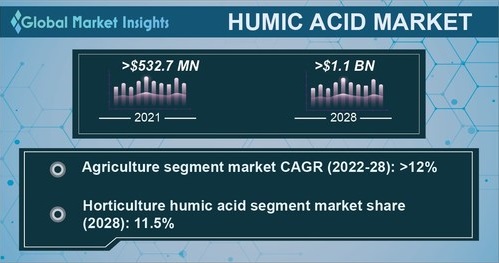A recent study by Global Market Insights Inc. speculates the global humic acid market size to surge beyond USD 1.1 billion by 2028, with the MEA region holding a notable share of the demand.
The humic acid market could be one of the promising remunerative verticals in the Africa bulk and specialty chemicals sector. One of the main reasons for this is the increasing food insecurity and the subtly rising practice of sustainable agriculture in the region.
According to an FAO report, Africa is currently off track on the ‘Sustainable Development Goal 2’ targets to end hunger and enable proper access to nutritious, safe, and sufficient food to its population all year round. Recent statistics by the organization demonstrated that nearly 281.6 million people in the continent faced hunger in 2020.
To this end, farmers and agriculturists across the region are looking to practice organic farming to augment the soil texture and crop productivity. This has paved the way for the introduction of organic compounds and solutions like humic acid.
How the growth of organic farming in Africa is proving beneficial for the regional humic acid market
Farmers across the African continent are now working on organic agriculture as it is considered to promote food systems that augment living conditions and enhance food security across various economies. Currently, only about 0.2% of the agricultural land in Africa is employed for organic farming.
Organic ingredients industry in Africa can be highly competitive, not only in the terms of internal competitiveness with conventional production but also based on being able to compete with global players. Introduction to new initiatives and techniques for promoting sustainable agriculture across diverse African economies would prove to be a contributing factor for the growth of humic acid consumption.
Underlining the major organic/sustainable agriculture initiatives in Africa:
South Africa: In 2021, the European Commission introduced several programs via the SWITCH Africa Green, in an attempt to ensure that sustainable agriculture is accomplished by practicing Sustainable Consumption and Production. These programs focused on the smallholder farmers of the MSMEs in South Africa to help the country achieve the Sustainable Development Goals and support zero hunger.
Nigeria : According to the Nigerian Export Promotion Council, Nigeria’s organic agriculture industry could generate nearly N150 billion (approx. USD 360 million) in the coming 5 years. This growth can be encouraged by the rising initiatives in the country.
An example of the same is the Youth Initiative for Sustainable Agriculture Nigeria’s role in enabling children, women, men, and senior citizens to become familiar with sustainable agriculture. The organization aims to make the students of agriculture in the nation business savvy while rebranding the sector. With such initiatives at their peak, the demand for humic acid could phenomenally rise.
Boosting the cotton yield and fiber quality
As per reliable studies, fulvic acid (a macromolecular organic compound of the humic acid) is known to show that the application of the compound in cotton fields could help reduce irrigation requirements, limit the shedding of bolls and buds, enhance cotton quality and yield, and improve the growth of cotton plants. Not to mention, the compound can also be used to augment the effect of urea and reduce the loss of nitrogen volatilization in the crop.
What is in the future for humic acid market?
An organic compound, humic acid is considered to promote crop growth and the return of beneficial fungi that might be absent in many soils. These compounds are macro-friendly, reduce phosphate lock-up, and enhance nitrogen efficiency, and are thus ideal organic agriculture ingredients for farmers across different economies in the African continent to curb hunger.
While the agriculture industry remains a niche vertical for humic acid suppliers globally, the food and dietary supplements sectors are also anticipated to emerge prominent revenue pockets in the near future. In recent years, people have begun opting for humic acid supplements for stimulating the immune and gut systems.
Companies are participating in the development and commercialization of humic or fulvic acid supplements that seek to alleviate the conditions of undernourishment. For instance, in 2020, the Goodly Company and Doc of Detox presented chemical-free humic and fulvic dietary supplements to combat nutrient starvation. With the influx of novel products on a frequent basis, the humic acid industry is sure to witness a significant surge in revenue in 2022 and beyond.
Source: https://www.gminsights.com/industry-analysis/humic-acid-market








